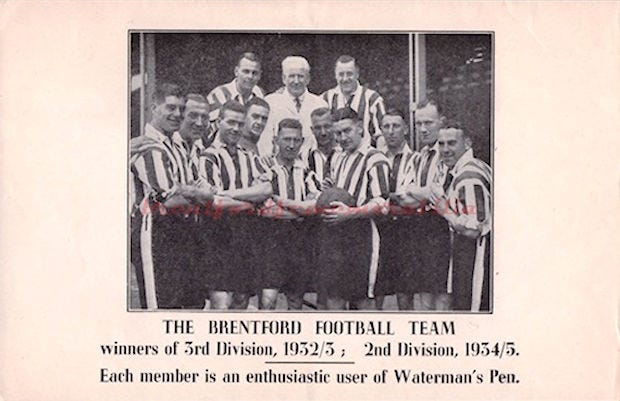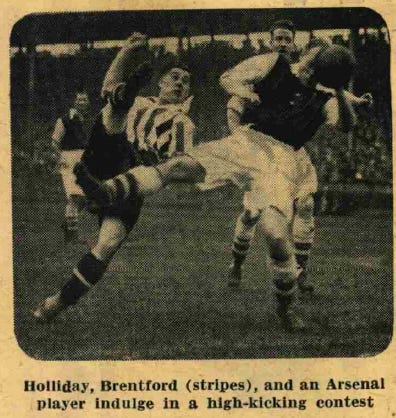When Brentford ruled London
The story of how Brentford became a thorn in Arsenal's side during the 1930s.
In the mid-1920s, an ambitious but so far unsuccessful London football club appointed a new manager.
He was revolutionary, transforming his new club and bringing them previously unheard-of success at the top of the English game.
He brought the club its first championships and trophies, and the team bettered their local rivals time and again in the years leading up to the Second World War.
Off the pitch, he helped improve the club’s facilities and raise standards, while proving particularly astute with transfers.
His initials were HC.
I’m talking, of course, about Brentford’s greatest ever manager, Harry Curtis.

Brentford, then of the Third Division South, appointed Curtis in 1926, a year after Arsenal hired Herbert Chapman. Curtis’ impact was almost immediate: Brentford reached the fifth round of the FA Cup in 1926-27, beating First Division West Ham on the way, and the club used the money to redevelop part of its stadium.
In 1929-30, Brentford finished second in the Third Division South, seven points behind champions Plymouth Argyle. While the Bees missed out on promotion (only the champions went up), they set an astonishing record by winning all 21 of their home games.
After a few near misses, Brentford finally clinched the Third Division South title in 1932-33 and the Second Division title two years later. The latter success marked the first time that all three divisions had been won by London teams, as Charlton Athletic were crowned Third Division South champions and Arsenal clinched the third in their hattrick of First Division titles.
(You can read an account of the 1934-35 season finale for Brentford from the club’s website, which has an extract from The Big Book of Griffin Park.)

At the top table for the first time
The 1935-36 season saw Brentford taking on the best teams in the land for the first time. The Bees acquitted themselves incredibly well, finishing fifth – one point and one place above all-conquering Arsenal.
The Gunners visited Griffin Park for the first time in a league match on 2 November 1935. It had been a middling start to the season for the reigning champions with five wins, four draws and three defeats, but Arsenal were confident against a newly promoted side. Forwards Ted Drake and Cliff Bastin had six goals each already, so goals were not going to be a problem.
Or so they thought.
Brentford raced into a two-goal lead before half time with goals from John Burns and Idris Hopkins. Arsenal struggled for any sort of foothold, the defence pinned back by a relentless home attack. Burns was apparently not fully fit - one of the “crocks” from the above headline - but that didn’t stop him outwitting the Arsenal back line.
Ted Drake was kept unusually quiet while playmaker Alex James couldn’t find space among Brentford’s hassling defenders.

In the second half the Gunners played better, Bastin drawing particular praise in subsequent newspaper reports as he drew good saves from Brentford goalkeeper James Mathieson.
It was left to Ray Parkin - making his first appearance for the Gunners’ first team in two years - to steal a goal for the visitors on 77 minutes. That was as good as it got, though, and Brentford held on for the win.
Former Arsenal player turned football journalist Charles Buchan wrote in the News Chronicle on 3 November 1935:
Before half-time Brentford outclassed their mighty rivals. Indeed, I have never previously seen the Arsenal forced to play second fiddle so completely. Although they were rather lucky when scoring the two goals, Brentford certainly merited them.
Brentford earned a 1-1 draw on their first visit to Highbury later in the season, but may have regretted not doing better as Arsenal’s squad was depleted by international call-ups.
There was no James, Bastin or Drake in the forward line and no Male or Hapgood at the back for the game on 4 April 1936. Bernard Joy, an amateur, was drafted in at centre-half - a month before he received his first and only England cap, becoming the last amateur to appear for the national team.
Jack Holliday put the Bees 1-0 up but they failed to take advantage of several other opportunities. Arsenal’s Peter Dougall scored late on to steal a point for what was essentially Arsenal’s reserve team.
These results set the tone for the Arsenal-Brentford rivalry to come. The Bees proved exceptionally hard to beat for the Gunners over the next few years.
Even in the Gunners’ 1937-38 championship-winning season, Brentford did the double over Arsenal, winning 2-0 at Highbury and 3-0 at Griffin Park. It took until the last day of the 1938-39 season for Arsenal to finally secure a win over the Bees, winning 2-0 on 6 May 1939 in what was essentially a dead rubber.
Kings of London
Arsenal were not the only team that struggled to get the better of Harry Curtis’s Brentford side.
From the Bees’ first season in the First Division in 1935-36 to the final campaign before the Second World War, Brentford had the best record in London derbies in each season. Even when Arsenal won the league in 1937-38, Brentford’s derby record was better than the champions’.
After three successive top-six finishes, Brentford struggled in 1938-39 and only avoided relegation by four points. Despite this, they were still the best team in London, winning four of six derbies.
During the war Brentford’s success continued. Harry Curtis’s men won the London War Cup in 1942, knocking Arsenal out in the semi-final before beating Portsmouth 2-0 at Wembley.
Post-war blues
Unfortunately, in the first post-war season of the Football League, Brentford could only manage nine wins all season and were relegated.
The pre-war Kings of London were dethroned, losing five of six derbies. Their only derby point came almost inevitably from a visit to Highbury, which ended in a 2-2 draw, as if to cement the fact that Brentford wanted to remain a thorn in Arsenal’s side.
Harry Curtis eventually stood down in 1949. He is still highly regarded at Brentford today, and the club’s boardroom is named after him. Current manager Thomas Frank – who repeated Curtis’s success in 2021 when he achieved promotion to the Premier League – has been compared to his predecessor often by fans.
Perhaps the result of Arsenal’s first league meeting with Brentford since 1949, on the opening day of the 2021-22 season, should not have been as much of a surprise as it was deemed. That’s a story for another day, though. (Specifically, tomorrow.)
For the record, here is proof that, even if just for a few years, Brentford were once the Kings of London.
Note: Two points for a win. Before the 1976-77 season, teams level on points were separated on goal average (GA), i.e. goals scored divided by goals against. Source: Author’s own research.
All newspaper cuttings sourced from the British Newspaper Archive.















